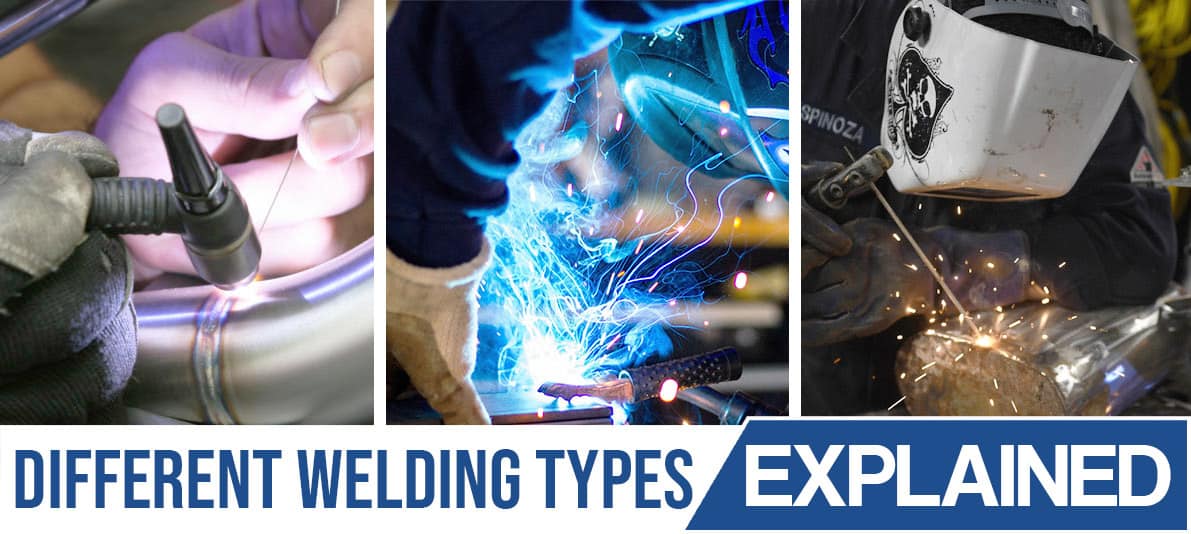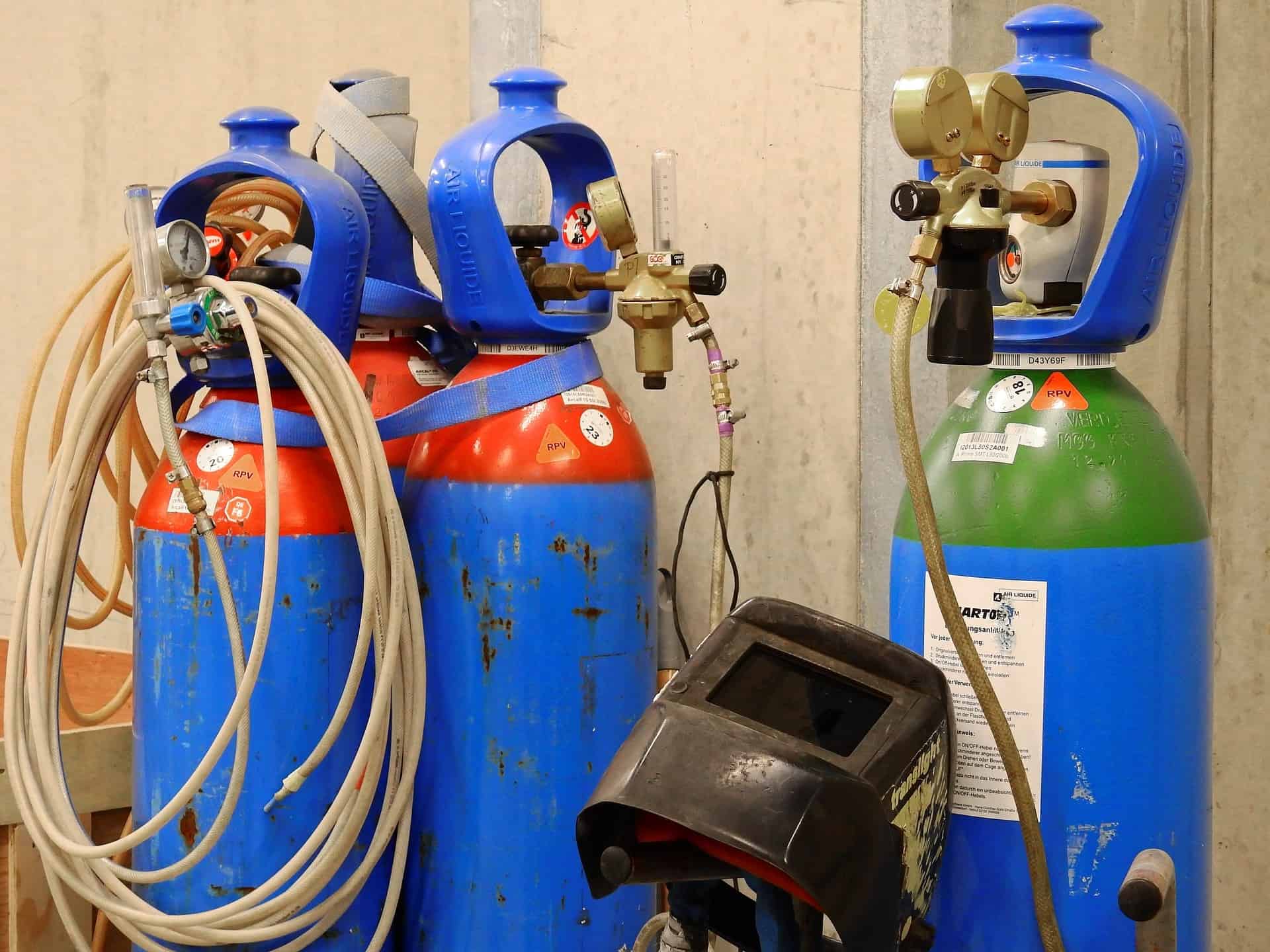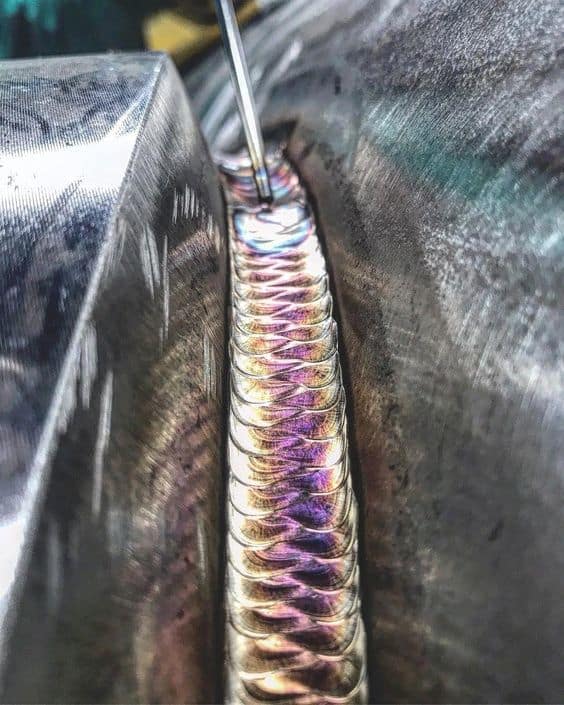Welding is a thrilling and enriching skill for amateurs and professionals alike.
By utilizing only a couple of tools and various metal types, welders can transfigure any piece into any form and shape they want, all with sparks zipping around as they work.

However, in order to master the art of welding, you need to start with the fundamentals and educate yourself about the various types of welding processes.
“There are more than thirty different types of welding. They range from outdated but still used oxy-fuel to high-tech methods such as laser beam welding. However, there are only four basic welding processes”.
They are MIG, TIG, Stick and Flux-cored arc welding. Each one of these has its own benefits and drawbacks and you must have adequate training to put them to practice.
Most known and widely used Types of Welding processes
(MMA, MIG, and TIG)
MIG Welding (Metal Inert Gas)
Also known as GMAW (Gas Metal Arc Welding). This welding technique uses a constantly fed electrode wire, which acts at the same time as electric conductor and added material, through a welding gun. The operator has to pull a trigger in order to feed the consumable electrode through. Between the base material and the electrode forms an electric arc. This heats up the material until it attains the melting point needed to get it to meld with another.
MIG welders are the most popular welding machines for home and industry users alike. Valued for speed and ease of use. They are used on thin or thick metal sheets, on different metal alloys and with different combinations of flux or gas protection.
Shielding Gas (CO2, Ar, He)
For all types of welding, there needs to be a shielding bubble around the electric arc and melted metal puddle to protect it from atmosphere and oxidation. In this case, we use externally supplied protective gas and some of the most commonly used gases for this purpose are CO2, Argon, Helium or the mix of those.
Note that all of the gases used in MIG welding are inert gasses except CO2 and are not hazardous for humans except in large doses and with bad ventilation which can trigger severe problems.

Carbon Dioxide (CO2)
is cheap and cools the gun faster but it gives a lot of splatters. Carbon dioxide is Not an inert gas but active gas. What’s more, it is the only active gas that can be utilized in MIG welds. And in that case, its called MAG welding, hence MIG/MAG term.
Argon (Ar)
is more expensive and it gives nicer welds, low spatter and slightly better penetration. It’s good to mention that it is is much cheaper in the US than in Europe. Besides plain steel, it’s used with stainless steel, aluminum, nickel, and other metals.
Helium (He)
produces a rather hot weld, which makes for a good and quick welding speed, but helium is also quite costly. Helium is not as good a conductor of electricity as Argon, thus the arc voltage is higher but it’s a much better conductor of heat and allows you to weld faster.
Argon vs Helium
GTAW
MIG Welding – The Main Advantages
It’s easy to use and to master. Almost no skill is required for small repairs garage work. It’s a very fast way of welding. For example, it’s four times faster than stick welding. It has a medium to low heat input so it can be set to work with very thin sheets of metal. It has no slag and requires minimal clean up after welding if you don’t include splatter when using CO2 gas. It can be used in all positions.
Disadvantages are an added cost of gas, lower mobility then stick welding, can’t be used in windy places because the wind tends to blow off shielding gas, it has a lower penetration than stick and flux core and in turn whacker welds. Material needs to be 90% clean and corrosion has to be removed for the weld to be good.
It’s mainly used in the manufacturing industry because of its speed and low user training prior to welding in the automotive industry and in the maritime industry on shipyards. It’s most popular with average Joe for garage work in the yard and home repairs again because of its easiness for use and ability to weld thin metal sheets.
TIG welding (Tungsten Inert Gas)
Also Known as GTAW (Gas Tungsten Arc Welding). TIG is an acronym for tungsten inert gas and is technically referred to as gas tungsten arc welding (GTAW). The method makes use of a non-consumable tungsten electrode that transfers the current to the welding arc. The tungsten and weld puddle is preserved and cooled with inert gas, usually argon. TIG welding is very much like oxy-acetylene welding in such that you would use a filler material for build-up or fortifying.
Just as in the case of MIG welding, you will require an external gas supply. Some of the most conventional of them are argon and argon/helium amalgamations.
TIG Welding – The Main Advantages
TIG is a very versatile way of welding. It’s used in all places where you need a high quality, strong, clean, precise or aesthetically good weld. TIG welding is for the most part seen as the most acceptable welding technique used these days. The reason for this is that it brings on a pristinely clean weld that is nearly impossible to get with other welding methods. The method is most commonly used for welding aluminum (with AC current) and stainless steel because of an especially pleasing look and low heat input. It’s also used for pipes up to 5 mm wall thickness or for root passes on ticker pipes.
The main disadvantages are a low speed of welding and hazardous welding fumes not from welding itself but from the material that is being welded, which is as we said is mainly stainless steel or aluminum.
It is utilized just about everywhere in the welding industry. It’s commonly used in all sorts of power plants not to mention piping systems, aerospace welding and the automotive industry including motorcycles and bicycles. More about TIG welding here
Shielded Metal Arc Welding or Stick welding
Stick welding (SMAW), known also as MMA (manual metal arc welding) is a manual arc welding method that uses a replaceable electrode covered with a flux to lay the weld.
An electric current is used to form an electric arc between the electrode and the metals to be joined. The welded material and the electrode melt and form the pool of molten metal that cools to form a joint. The flux coating of the electrode disintegrates as the weld is laid. This will result in an emission of vapors that can serve as a shielding gas and provide a layer made up of slag. Both of these guards the weld area from atmospheric corruption.
Stick Welding – The Main Advantages (Shielded Metal Arc Welding)
The principal advantages of making use of the shielded metal arc welding technique are such as the inexpensive needed equipment and its ease of transportation. The gas is not necessary as with the TIG or MIG welding techniques. What that means is that you can use this welding process outdoors even during inclement weather.
Stick welding could be the most forgiving method for stained or rusty metal. However, you should not use this to justify not correctly cleaning the material. It can be used in any position and on any material depending on what electrode you use. There are special electrodes for all types of steel. It creates quality welds with high penetration and high heat input.
Disadvantages
Stick welding is one of the more difficult processes to learn. You will need at least a year to properly master it. It is one of the slower processes especially as you constantly need to change electrode, remove slag and clean with a metal brush.
Due to the adaptability of the process and the austereness of the equipment and operation, shielded metal arc welding remains one of the world’s most popularly used welding methods. It overpowers other welding methods in the repair and maintenance industry. It is also primarily used in pipeline work. Although flux-cored arc welding is increasing in reputation, SMAW is still used the most often in the construction of heavy steel edifices and in industrial manufacturing.
Flux Core Welding
Flux-cored welding is a valuable method for welders who very often need to weld outdoors or on material that is not the cleanest. It is simply no matter the welding skill of the user. Flux-cored arc welding (FCAW or FCA) is a semi-automatic or automatic welding method in which a hollow wire electrode is fed through the welder’s gun and into the joint.
Self-shielded flux-cored welding is different from MIG in that it doesn’t require an external shielding gas, such as CO2 or argon, to defend the weld pool from oxidation and contamination. Instead, a flux core on the inside of the wire reacts with the welding arc to create a gas that guards the weld pool. A resembling process, gas-shielded flux-cored welding, does have a need for protective gas. It’s often used in the industry of heavy-duty production and building. Thus, it is not generally recommended for amateur and novice applications.
This practice does not involve the weld problems that can happen when a sudden wind blows away the shielding gas when MIG welding outdoors. This is because the flux provides the shielding gas in self-shielded flux-cored welding.
The flux that is located inside the electrode permits the process to be more forbearing of base metal that is dirty, rusty, contaminated or has a thin coat of paint.
Flux-cored welding creates a slag that tops the finished weld and has to be taken off or chipped away as with the stick welding. For these causes and others such as visually unappealing welds compared to MIG, it’s wise to switch over to ordinary MIG welding when you are indoors.
MIG vs TIG
MIG and TIG welding are both arc welding processes that use an inert gas. This explains their other names, gas metal arc welding (GMAW) and gas tungsten arc welding (GTAW).
The main difference between the two is that MIG welding uses a constantly fed wire that also serves a purpose as a filler material. Meanwhile, TIG welding makes use of a non-consumable tungsten electrode. This sees to it that TIG welding makes the items being welded hot enough to meld together. On the other hand, MIG welding can permanently link objects by having the melting electrode be used as a filler material.
You cannot really compare two welding processes because they are mainly used for different things.
![Most Popular Types of Welding Processes [2024] 4 Welding MIG and TIG](https://weldingpros.net/wp-content/uploads/2020/01/Welding-MIG-and-TIG-974x1024.jpg)
Though both types can be used for thin metal sheets, MIG is used for ordinary steel and TIG for stainless steel, aluminum, and other metal alloys.
In industry, MIG and flux core welding is mostly used when there needs to be a large amount of welding. It welds four times faster than the electrode and is far faster than TIG. It’s very easy to learn and not hard to master. It’s a very versatile type of welding depends on what protective gas you are using and what wire has been fed into the machine.
On the other hand, you will use TIG when you need short, but quality or aesthetically pleasing weld like root pass on pipes or welds on places that will not be painted or embellished with a grinder like a motorcycle exhaust pipes or staleness steel fences.
Slowly adding material with another hand gives you total control over how the weld will look. There are very low amounts of visible welding fumes and no slag. You can clearly see what you are doing and have time to react.
So In Short
MIG (gas metal arc welding) is used mainly for plain steel. It’s fast and easy to learn and leaves decent welds. Ordinary people mainly buy MIG welding machines for home repairs and garage work. Industries use it because of its speed and versatility
TIG is used for stainless steel aluminum and other metal alloys. It’s slow but precise and gives quality welds that look good and have no need for brushing, grinding or painting. Experienced TIG welders have a higher salary than their colleagues and are always needed in the industry.
The average pay for a TIG Welder is $18.27 per hour. The average pay for a TIG Welder is $40,420 per year.
Less known And New Welding Processes
Laser Welding
Laser beam welding is primarily used for joining pieces that need to be joined with higher welding speeds, thin and small weld seams and low thermal distortion.
The high welding speeds, the superior automatic operation, and the better likelihood to have command over the quality online while the process is in action make laser welding a ubiquitous joining process in today’s industrial production.
![Most Popular Types of Welding Processes [2024] 5 Close-up of the laser welding torch in the light blue scene.](https://weldingpros.net/wp-content/uploads/2020/01/Close-up-of-the-laser-welding-torch.jpg)
To learn more visit rofin.com
Explosion welding
Explosion cladding is a solid-state welding method that makes use of controlled blasts to fuse two unalike metals while keeping the mechanical, electrical and corrosion abilities of both.
This practice is used most commonly to encase steel within a thin layer of a corrosion-resistant alloy metal such as silver, stainless steel, brass, titanium, nickel or zirconium.
It must be remembered that explosion welding can meld a varied choice of compatible and non-compatible metals. More than 260 metal combinations are possible.
To learn more, visit NobelClad or Mechanical Engineering Community
Resistance welding
Resistance welding is the fusion of metals by forcing extreme pressure and passing current for a long amount of time through the metal area which will be joined. The main benefit of resistance welding is that no other materials are necessary to produce a bond. This makes this process quite cost-effective.
There are many varied forms of resistance welding (For example; spot, seam, projection, flash, and upset welding) which mainly contrast by the kinds and forms of weld electrodes that are utilized to lay on the pressure and conduct the current.
![Most Popular Types of Welding Processes [2024] 6 Spot welding machine Industrial automotive part in factory. Operator working in industry .](https://weldingpros.net/wp-content/uploads/2020/01/Spot-welding-machine-Industrial-automotive-part-in-factor.jpg)
To learn more visit AWS.
Micro welding
Micro welding comprises of systems and also devices specifically designed for the purpose of carrying out, as the name suggests, micro-welding. It is designed primarily for the tiniest, thinnest, and most fragile of components by utilizing closely controlled heat energy.
As you will see in the proceeding video, the component is being fortified and fixed via the use of a micro TIG welder. Micro TIG welders are perfect for micro-welding because they are easily controlled by the operator.
To learn more visit sunstonewelders.com
Ultrasonic welding
Ultrasonic welding is an industrial welding method in which ultrasonic acoustic high-frequency vibrations are applied in a specific area to workpieces being forced together under great pressure to produce a solid-state weld.
It is most often used for plastics, and particularly for joining unalike materials.
To learn more visit howstuffworks.com
Orbital welding
Orbital welding is a designated area of welding in which the arc is turned about mechanically through 360° (180 degrees in double up welding) around a still workpiece. This can be an object such as a pipe in a constant process.
This method was invented to address the topic of the operator’s mistakes in GTAW welding techniques. In orbital welding, the computer-controlled method operates with almost no intervention from the operator.
![Most Popular Types of Welding Processes [2024] 7 Industrial operator setting computer controlled process of orbital welding machine in inox pipes manufacturing workshop.](https://weldingpros.net/wp-content/uploads/2020/01/Industrial-worker-setting-orbital-welding-machine..jpg)
The process is utilized almost exclusively with high-quality repeatable welding.
To learn more, visit TWI or Orbital Mechanics.






